Laptop Mag Verdict
The Razer Blade is a slim stunner that now packs GeForce GTX 970M graphics, making it a lightweight gaming powerhouse.
Pros
- +
Slim, attractive chassis
- +
Solid graphics and overall performance
- +
Bright and detailed display
- +
Good battery life for a gaming laptop
Cons
- -
Touchpad buttons too slim
- -
Expensive
Why you can trust Laptop Mag
The Razer Blade has been one of the best slim gaming laptops for a while, thanks to its successful combination of power and portability. The current iteration of this 14-inch machine ($2,399 as configured, $2,199 starting) updates the GPU to the more powerful Nvidia GeForce GTX 970M for a real boost when it comes to frame rates. Throw in an Intel Core i7 processor and lovely 3,200 x 1,800 display, and you've got a force to be reckoned with.
Design
This iteration of the Blade looks just as sharp as the original, because the chassis is pretty much the same. Not that I'm complaining. The beautiful ebony-aluminum design still entices, from the delicate lines across the lid to the emerald-green triple-snake emblem.
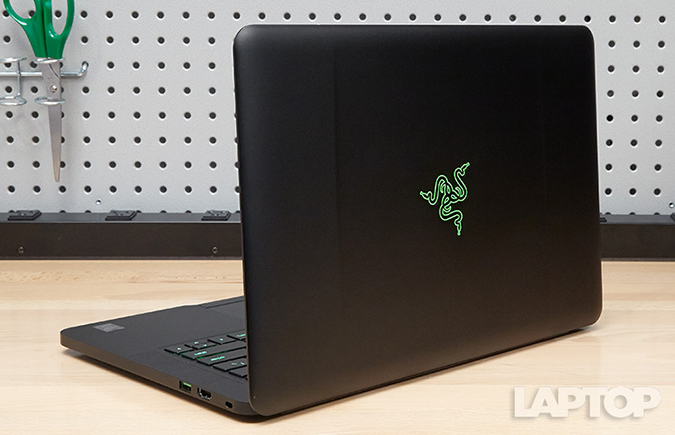
The incandescent green keyboard set in the black-aluminum interior is still plenty mesmerizing. There is very little fault to find with this simple, yet provocative design, but if I have to nitpick, I wish that I could customize the keyboard's backlighting.
At 4.4 pounds, 13.6 x 9.3 x 1.0-1.1-inches, the Blade is heavier than the Aorus X3 Plus V3 (4 pounds, 12.9 x 10.3 x 0.9 inches) but slightly lighter than the Alienware 13 (4.5 pounds 12.9 x 9.3 x 1.0-1.1 inches).
Display
Razer retained the 3,200 x 1,800 touch display from last year's model, which is big on detail and delivers an awesome gaming experience. When I loaded my Grand Theft Auto V game save, I didn't have to fiddle with color calibration. My candy-red lowrider gleamed in the sunlight as I drove down the coast. The blue-green water looked picture-perfect against the cloudless blue sky. As I drove through a parking garage, the shadows looked realistic in varying shades of black and gray.
MORE: Best Gaming Laptops
When I was viewing the 4K Interstellar trailer on the Blade next to my 13-inch MacBook Pro (2,560 x 1,440), Matthew McConaughey's skin had an orange tinge on the Blade. The actor's bronzed complexion looked better on the MacBook. However, I noticed that I could see more of the actor's beard stubble on the Razer compared to the MacBook, and that I could make out more detail in shadows.
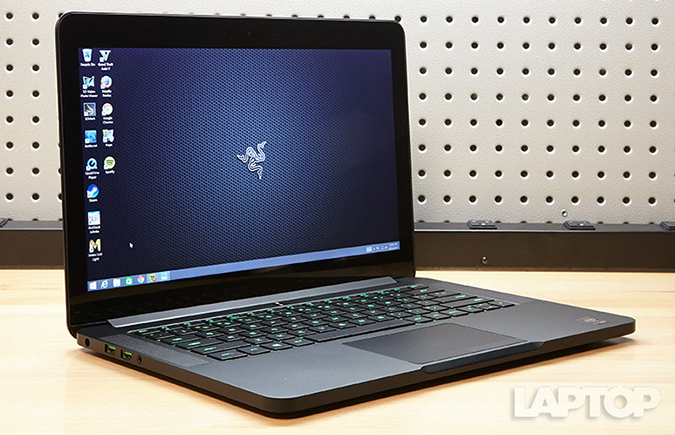
The Blade can reproduce 101.8 percent of the sRGB color gamut, which is slightly higher than the 100 percent we look for. The Aorus X3 Plus notched a slightly higher 106.3 percent.
On the Delta-E test (color accuracy), the Blade registered 1.2 (scores between 1 and 0 are ideal). The Aorus X3 produced a dismal 10.7.
When measured for brightness, the Blade's display scored a dazzling 337 nits, destroying the 231-nit thin-and-light average. The Aorus hit 203 nits.
The 10-finger capacitive display was agile and responsive to my touches, pinch-zooming and highlighting items accurately.
Audio
The Blade easily filled our medium-size lab with sound. However, the machine's top-mounted speakers didn't produce the most precise audio I've heard. Despite the Dolby Digital Plus software, the Blade struggled to replicate the bass on Jay Z's "No Church in the Wild" and Kool and the Gang's "Summer Madness," which resulted in compressed-sounding lows.
The highs weren't that much better, leaving Beyonce's powerhouse soprano sounding flat and uninviting during "Love on Top." The Mellotron keyboard on "Summer Madness" was grating at high volume, while the guitars on Van Halen's "Hot for Teacher" sounded a bit strained.
Once again, the Blade put its best foot forward during gaming. As I played GTA V, the dialogue was on point. Trading gunfire with random cops and gang members was punchy, but the music still lacked the oomph I would have expected.
Gaming and Graphics
The Razer Blade is like a concealed weapon -- small and unassuming, but with the capacity to cause lots of damage. Outfitted with Nvidia's second-most-powerful mobile graphics card, the GeForce GTX 970M (with 3GB of VRAM), the Blade delivers impressive frame rates.
During my runthrough of GTA V, I engaged in a few street races, went on a hike and got a haircut, all in beautiful 3,200 x 1,800. With all the settings cranked to high, the game sailed along at a smooth 40 fps. There wasn't a jagged texture to be found as I mowed down slow-moving pedestrians while drifting around a particularly sharp corner. It was exhilarating to say the least.
On the BioShock Infinite benchmark, the Blade held its own against notebooks equipped with the same GPU. On low at 1080p, the Blade hit 128 fps, beating the 102 fps thin-and-light average, but not the Aorus X3 (154 fps). When we flipped the settings switch to high, the Blade produced 71 fps, just behind the Aorus (72 fps).
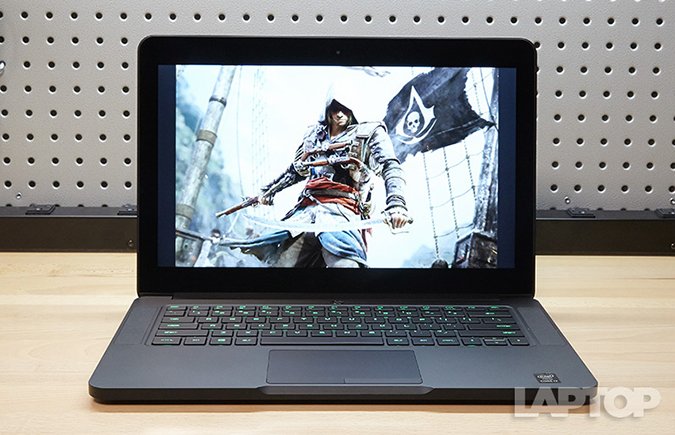
Laptops with 970M cards don't have the power to play taxing games such as Metro: Last Light with all the eye candy turned on, but can still push great frame rates on lower settings. At 1080p on low, the Blade achieved 95 fps, surpassing the 80-fps average but falling short of the Aorus' showing of 99 fps.
At native resolution (3,200 x 1,800) on low settings, the Blade hit 56 fps, a couple of frames behind the Aorus' 58 fps. But the Blade's showing was still enough to coast past the thin-and-light category average of 41 fps. At the highest setting, the Blade's frame rate dropped to an unplayable 12 fps.
On the 3DMark Fire Strike benchmark, the Blade registered 6,550, pummeling the 1,637 average. The Aorus was a close second, at 6,391.
Editors' Note: The Alienware 13 isn't included in our comparisons because we have yet to review the recently refreshed system. We will update this review once we've run our tests, but keep in mind that the notebook will feature a relatively weaker Nvidia GeForce GTX 960M GPU.
Performance
When you're not gallivanting around some fantasy world and liberating its citizens, the Razer Blade is a multitasking, multimedia monster. The laptop's 2.6-GHz Intel Core i7-4720HQ processor with 16GB of RAM streamed the latest episode of "Sailor Moon Crystal" on Hulu while running a full-system scan with 10 open tabs in Google Chrome, Mozilla Firefox and Internet Explorer.
The notebook hit 10,915 on Geekbench 3, beating the 6,639 thin-and-light average. However, the Aorus X3 and its 2.5-GHz Intel Core i7-4710HQ processor scored 12,863.
MORE: Best Gaming Desktops
The Blade's 256GB SSD notched a speedy 182 MBps on the File Transfer test (duplicating 4.97GB of multimedia files), which is nearly twice the 97.7-MBps average. The Aorus X3's dual 256GB mSATA SSDs delivered a scorching 299 MBps.
During the OpenOffice Spreadsheet Macro Test, the Blade matched 20,000 names and addresses in 3 minutes and 46 seconds. That's faster than the 5:30 average as well as the Aorus' score (3:52).
Keyboard and Touchpad
Just like its predecessors, the Blade has an island-style keyboard, including the distinctive font and haunting green backlighting. The flat, black keys offered bouncy feedback as I wrote this review. The keyboard has 1.5mm of key travel with 68 grams of actuation, which allowed me to hit my usual 60 words per minute on the 10 Fast Fingers Typing Test.
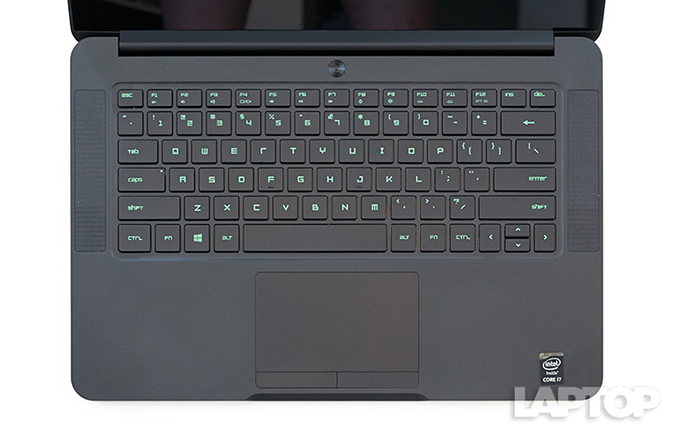
The 4.2 x 2.5-inch Synaptics touchpad looms large on such a small palm rest. Highlighting text within documents and websites was a breeze, as was performing Windows 8.1 gestures. Multitouch commands such as pinch-zoom, two-finger rotate and three-finger press or flick were easy to pull off.
Both discrete mouse keys delivered firm feedback with audible clicks. My only complaint continues to be with the buttons' slimness. If Razer could just add a millimeter or two, these buttons would be great.
Synapse 2.0
Razer's cloud-based software lets you adjust the brightness of the keyboard's backlighting, create custom profiles for specific games and apps, and record macros.
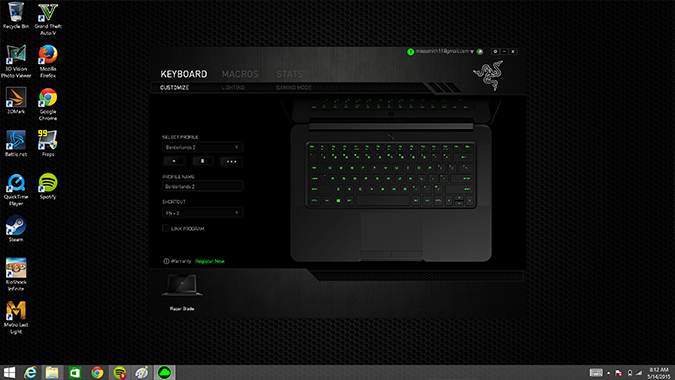
You can also track your button presses, mouse clicks and movements via a heat map to help analyze how well you're playing on chosen games.
The above information gets saved to the cloud and can be accessed from other Razer notebooks.
Heat
For everyday tasks like sending email or watching videos, the Blade keeps its cool. After streaming a full-screen Hulu video for 15 minutes, the touchpad registered 77 degrees Fahrenheit, and the space between the G and H keys was 88 degrees. The bottom of the notebook measured a warm 90 degrees, but still below the Laptop Mag comfort threshold of 95 degrees.
After I spent 15 minutes traipsing around Grand Theft Auto V, the touchpad's temperature rose to 86 degrees while the space between the G and H keys leapt to 94 degrees. The undercarriage measured a hot 102 degrees. But the hottest point of the laptop, the space between the display and the deck, reached 110 degrees. This is by design, as the Blade disperses heat far from where players' hands are likely to be.
The Blade has dual fans to keep the laptop at a reasonable temperature. Unfortunately, the cooling system is only marginally quieter than my hair dryer. When I was typing this review or surfing the Web, the fans would roar to life. It was distracting enough that several co-workers came to investigate the source. We reached out to Razer to troubleshoot and came to the conclusion that the problem lay with Windows 8.1 and not the hardware.
Webcam
The photos I took with the Blade's 1080p webcam lacked vibrancy and detail.

My complexion looked ashen, and my bright red sweater appeared rust colored. I also had trouble seeing the green stripes in my colleague's plaid shirt. Larger details, such as the lettering on the Laptop banner in the background, were easy to make out.
Ports
Razer gives gamers just enough ports to plug in essential peripherals, such as mice and headphones. A single USB 3.0 port sits on the right, with a full HDMI port and a Kensington lock slot.
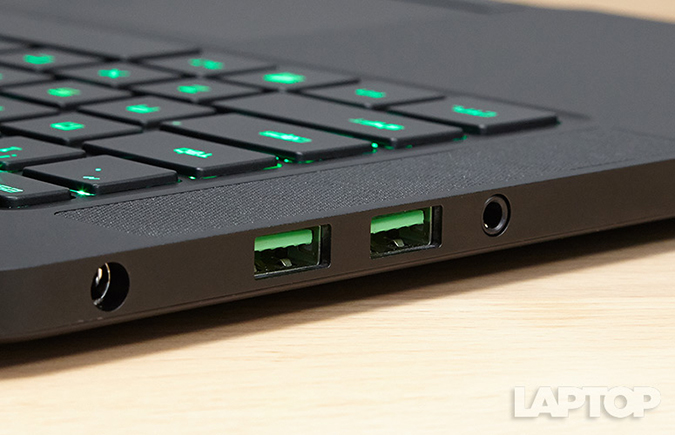
On the left, you'll find another pair of green-tinted USB 3.0 ports with jacks for headset and power.
Battery Life
You don't expect a gaming laptop to have good or even decent battery life, but the Razer Blade bucks the trend. The ebony beauty lasted 5 hours and 52 minutes on the Laptop Mag Battery Test (continuous Web surfing over Wi-Fi). That's shorter than the 7:12 thin-and-light average, but good for a gaming notebook and longer than the Aorus X3's time (5:38).
MORE: 10 Laptops with the Longest Battery Life
Software and Warranty
Befitting its svelte frame, the Razer Blade has virtually no bloatware. Aside from Synapse 2.0 and Windows 8.1 apps such as Food & Drink, Weather, and Calendar, the Blade doesn't host any third-party apps.
The Razer Blade comes with a one-year limited warranty.
Configurations
The $2,399 unit I reviewed packs a 2.6-GHz Intel Core i7-4720HQ, 16GB of RAM, a 256GB SSD, an Intel HD Graphics 4600 GPU and an Nvidia GeForce GTX 970M GPU with 3GB of VRAM. For $200 less ($2,199), you can get the Blade with a 128GB SSD, while another $300 ($2,699) will net you the configuration with a 512GB SSD.
If you're looking to save a couple of hundred dollars, Razer also offers the Blade with a 1080p nontouch display for $1,999. That model also has a 2.6-GHz Intel Core i7-4720HQ, 8GB of RAM, a 256GB SSD, an Intel HD Graphics 4600 GPU and am Nvidia GeForce GTX 970M GPU with 3GB of VRAM.
Bottom Line
Razer continues to dance gracefully along the edge of power and portability. The updated Blade ($2,399) retains some of my favorite things (design, keyboard, display and battery life) and updates the rest with a powerful Core i7 processor and Nvidia GeForce GTX 970M GPU. The result is a laptop that not only delivers solid frame rates, but can also easily double as a powerful multimedia or business notebook.
However, the Blade is a bit pricey. You could save a couple of hundred bucks and get the Aorus X3 Plus V3 ($2,199), which offers a lighter chassis and comparable graphics performance. Overall, though, the Razer Blade remains the go-to choice for those who want a lightweight gaming rig with a surprising amount of punch.
Razer Blade (2015) Specs
| Bluetooth | Bluetooth 4.0 |
| Brand | Razer |
| CPU | 2.6-GHZ Intel Core i7-4720HQ processor |
| Company Website | http://www.razerzone.com |
| Display Size | 14 |
| Graphics Card | Nvidia GeForce GTX 970M/intel HD Graphics 4600 |
| Hard Drive Size | 256GB |
| Hard Drive Speed | n/a |
| Hard Drive Type | SSD Drive |
| Native Resolution | 3200 x 1800 |
| Operating System | Windows 8.1 |
| Optical Drive | None |
| Optical Drive Speed | n/a |
| Ports (excluding USB) | HDMI, Headset, Kensington Lock, USB 3.0 |
| RAM | 16GB |
| Size | 13.6 x 9.3 x 1.0~1.1 inches |
| Touchpad Size | 4.2 x 2.5 inches |
| USB Ports | 3 |
| Video Memory | 3GB |
| Warranty/Support | One-year limited warranty |
| Weight | 4.4 pounds |
| Wi-Fi | 802.11 b/g/n/ac |
| Wi-Fi Model | Intel Wireless-AC 7260HMW |

Sherri L. Smith has been cranking out product reviews for Laptopmag.com since 2011. In that time, she's reviewed more than her share of laptops, tablets, smartphones and everything in between. The resident gamer and audio junkie, Sherri was previously a managing editor for Black Web 2.0 and contributed to BET.Com and Popgadget.
